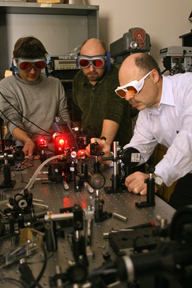Imagine being able to detect if an area is good for oil drilling without having to dig. Or detect low-level explosives, drugs or biological weapons in a bag at an airport without searching it. Or catch the early stages of a disease such as diabetes or cancer — just by smelling the breath of a human.
 |
| Sergey Mirov, right, Vladimir Fedorov, center, and Igor Moskalev test equipment that makes up the Optical Nose, a laser-system invention that could aid in predicting diseases and be used for security purposes. |
Sergey Mirov, Ph.D., professor of physics and co-director of the Center for Optical Sensors and Spectroscopies, is aiming to accomplish this and more by creating what he calls an Optical Nose.
The laser-based Optical Nose will allow for rapid identification and quantification of organic trace-gases in multi-compound gas mixtures with full biochemical specificity and high sensitivity. And, to top it all off, the Optical Nose will have sensitivity more than 100 times better than that of a dog nose.
“We have developed several inter-related laser technologies that provide access to the ‘molecular fingerprint’ middle-infrared range of the optical spectrum,” Mirov explains. “With the development of these technologies, our goal is to develop an Optical Nose capable of identifying 20 to 30 biomarkers of specific diseases in one scan.”
Studied under the best
Mirov, who came to UAB from Russia in 1993, studied laser physics and technology under Alexander Prokhorov at the Russian Academy of the Sciences. Prokhorov, Nikolai Basov and Charles Townes won the Nobel Prize for Physics in 1964 for fundamental research in quantum electronics that led to the development of the maser and laser, so Mirov’s training has come under some of the best.
Why did Mirov choose to call his invention the Optical Nose? “Because our system simulates functions of biological olfaction,” he says. In other words, the system’s technology effectively mimics a magnified sense of smell and displays it in an optical domain in the form of absorption patterns specific to each detected molecule.
How does the Optical Nose work? For ultimate performance, optical detection has to be performed in the so-called molecular fingerprint region. This region is located in the mid-infrared wavelength range between two and 20 microns. In this region, all organic molecules possess a dense series of strong, narrow-band absorption lines. By measuring the light absorption in a gas sample at a large number of different wavelengths in the fingerprint region, nearly all molecules can be identified and individual concentrations measured.
Mirov’s invention comprises three different lasers — a fiber-bulk pump laser, a seed laser and an Optical Parametric Generator. Combined in one system, the lasers, acting as the heart of the Optical Nose, provide a high-power, narrow linewidth, ultra-broad and rapidly tunable radiation capable of resonantly exciting the strongest absorption lines of any organic molecule. This laser system, in conjunction with compatible sensing, signal enhancing and molecule identification techniques, can satisfy the challenging demands of real-time analysis and quantification of a measured sample.
Mirov says there are devices available that can measure light absorption in a gas sample, but the spectral coverage of these systems is very limited. That’s what makes the Optical Nose better. The range of tunability is such that it can detect basically all biomarker fingerprints where others cannot.
“We have designed individual components of the Optical Nose, enabling broad and rapid tunability in the middle-infrared,” Mirov says. “That’s what makes it so unique. Now we have to put everything together, package it and start experimenting.”
Needing help
The laser component of the Optical Nose is currently sponsored by the NSF Biophotonics program and the UAB Research Foundation. Collaborations have been established with the Larry DeLucas Center for Biophysical Sciences and Engineering and its engineering division, directed by Lee Moradi. “To build a viable prototype and validate its performance,” Mirov says, “the team needs additional funding and effective collaboration with the biomedical community.
“We believe the Optical Nose can open a completely new era in medicine, enabling its predictive role at the very early stages of diseases,” he adds.
For more information on the Optical Nose, contact Mirov at mirov@uab.edu .